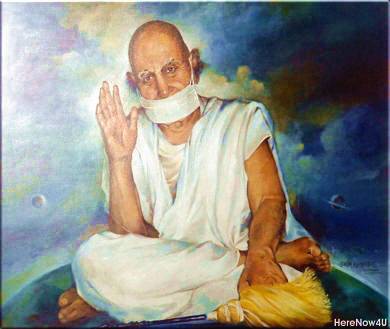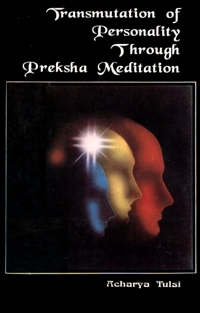
The Difficult path of sadhana grows easy and accessible
To a sadhak blessed with the guru's guidance sweet;
Mahavrati Acharya himself rapt in meditation,
Tolerant, free, gentle, straight, occupying the teacher's seat,
And well-conversant with preksha yoga,steadfast,
Renowned as an experienced teacher, efficient and wise.
To prepare the ground for meditation and to seek the path of sadhana, should a sadhak work on his own or should he work under the supervision of some capable teacher?
There are two kinds of sadhaks:
- self-awakened or
- awakened by instruction.
Those belonging to the first category are rare. These make their way themselves and tread it without any fear of obstruction. In whatever direction they move, a new path is created. Such people do not need any guidance from a guru.
But for those sadhaks whose wisdom is not yet awakened, and who are unacquainted with any system of sadhana and dare not traverse an unknown path, the guidance of a capable guru is essential.
The importance of the guru is recognized in all spheres. Even to learn some little craft, one needs an instructor. And the great craft of meditation cannot be learnt without the supervision of a teacher. Meditation is wholly an internal process. The secrets thereof are available, not through books, but through direct experience. Book knowledge can give us information about the whole world, but the knowledge of oneself cannot be gained through books. To know oneself, one has to seek the guidance of a guru. The guru is experienced. He himself practises meditation and acquires experience which he distributes among the inquiring sadhaks, thereby adding to his own knowledge. With the help of the guru, the difficult path of sadhana becomes easily accessible. A Rajasthani poet has given expression to this very fact in a couplet:
I walked and walked for ages, yet knew not where I was;
Then met a guru, and lo! my goal seemed not far off!
As far as knowledge of material things is concerned, some people may behave indifferently towards their teacher. They may feel that what they are seeking could be got from other sources as well. But inner knowledge, which only a guru can impart, cannot be gained through any other means. To obtain inner knowledge, a sadhak looks up to his guru for support, and he, therefore, obeys the guru implicitly with perfect humility and dedication.
He who works under the supervision of a guru, gradually moves forward. Wherever he comes across a hurdle in his path, that hurdle is removed and the sadhak is never left in the lurch. In the absence of right guidance, there is always the possibility of going astray. Those who, after reading a few books or hearing about meditation from some friend, start their sadhana on their own, get bored within 5-10 days, and discontinue their practice, or they go astray. Being confused their mind loses its balance. An unbalanced mind and sadhana do not go together.
In such a situation, a man loses faith in himself as well as in the method of sadhana he has adopted. His lack of faith disperses the vibrations of his faithlessness all around. These may adversely affect some immature sadhak. From this point of view, for making progress in the field of sadhana, it is very necessary for a man to seek the guidance of a really capable guru.
You say the guidance of an able guru is essential for sadhana. Such guidance will certainly bring about good results. But what is the criterion for determining a guru's worthiness? What touchstone have we to test our guide?
There can be no precise definition of a guru. Still on the practical level, a man would want a definition. Unless unlimited space is confined within the bounds of a house, a man cannot live in it. A guru's grandeur beggars description. No words can adequately express it; it can only be defined on the ground of behaviour. On behavioural ground, a guru is one who is a mahavrati.
The man whose soul is not impregnated with the spirit of the great vows cannot be an adept in the practice of meditation. Besides being a mahavrati, he must also have a deep interest in the practice of meditation. Because in the absence of such interest, he can neither do any experimentation in the field of meditation nor can he inspire others to do it.
For training in meditation it is also very necessary to achieve control over the passions. Victory over the passions results in forgiveness, freedom, straightforwardness and gentleness.
- He who conquers anger, becomes tranquil;
- he who conquers greed is free-without any desire for self-profit;
- he who conquers illusion, is straight, and he who defeats pride, grows tender and mild.
For salvation one must conquer the passions. In the Sthanang Sutra are mentioned four doors to religion:
- tolerance,
- freedom,
- simplicity, and
- compassion.
These four religious doors are also the doors to salvation.
Without entering these, there can be no sadhana. Because the chief objective of one's dhyana-sadhana is the achievement of freedom from passions and affections.
A sadhak who has not achieved this freedom cannot initiate others into meditation, because the whole practice of meditation is the practice of veetaragta. Only a person who has accomplished this sadhana can adorn the exalted seat of the guru.Some masters adept in breath-control and breath regulation also become gurus of dhyana. They do acquire certain elements of meditation. But their progress is confined to the achievements of this world and thaumaturgy. Spiritual meditation cannot succeed without the practice of tolerance, freedom, simplicity and compassion. Without such practice there can be no entrance to spiritual progress.
Thaumaturgy is also an accomplishment. A man exhibiting marvels can fill innumerable people with admiration. But this is not the process of transmutation of personality. Through such exhibition, a man does not become introversive. For introversion or transformation of personality, one must set aside all marvelmaking and give oneself up wholly to sadhana for veetaragta, i.e., freedom from passions.
A possible definition of a guru could be: "Expert in preksha-yoga". He who has practised preksha dhyana, has become skilled in it, and achieved perfect equanimity, can shoulder the responsibility of a guru. To be able to discharge his obligations, it is absolutely necessary for a guru to be enlightened to possess subtle knowledge. Subtle knowledge is of two kinds: affirmative and nugatory. A guru is a master of both kinds. His knowledge is most comprehensive. Only that individual is enlightened who has the capacity to know, to change, and to surrender. Only he whose consciousness is awakened, can become a guru.Given a worthy guru, an enquiring pupil and adequate facilities for sadhana, progress on the path of meditation is assured.
 Acharya Tulsi
Acharya Tulsi
